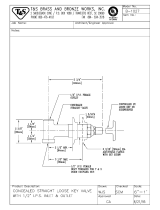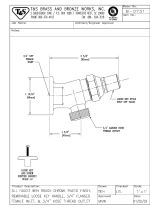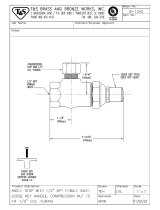
across these terminals to replace on/off controls and
provide for constant operation.
Caution: Terminal 1 is the “hot” wire from the
24Vac control transformer; it will trip the 3A breaker on
the transformer if any control field wiring touches
ground metal.
GHP MODELS
GHP models accept a single 0-10 VDC or 0-20
mA control signal (see D on Figure #8) across
terminals 4 and 5 on the low voltage terminal strip to
generate a modulating output from the humidifier.
Terminals 1 and 3 are 24 Vac and ground respectively
and may be used to power a remote mounted
modulating humidistat.
An on/off security loop exists across terminals 1
and 2 and should be wired as described for GHB
models.
GHMC MODELS
GHMC models may be configured for either single
or dual channel modulation. Control signals can be
0-10 VDC or 0-20 mA (0-5 VDC, 1-5 VDC, 4-20 mA
and 2-10 VDC are also available). The unit must be
ordered from the factory for the desired signal type
and number of channels. When configured for
2-channel modulation the humidifier will generate
steam only if both channels indicate a demand (see
D&E on figure #8). If both channels are demanding
steam the humidifier will satisfy the lower demand
signal.
An on/off security loop exists across terminals 1
and 2 and should be wired as described for GHB
models.
CONTROL INSTALLATION
1. Mount any wall humidistat (control or high
limit) over standard electrical box at height
similar to typical thermostat. Any wall
humidistat should be in location representative
of overall space being humidified and not in
path of blower pack or air supply grille. Do not
mount on an outside wall where temperature
fluctuations can affect control response.
2. Mount duct humidistat in location
representative of overall air humidity, usually
in return duct. Do not mount it directly in front
of steam distributor or in turbulent or mixing
zone. Mount humidistat where air's humidity
and temperature are uniform and
representative of spaces being humidified.
3. Mount duct high limit humidistat downstream
of steam distributors far enough that, under
normal humidity and air flow conditions, steam
will have been fully absorbed (typically at least
10 feet). It must be located to sense high
humidity only when uniform and representative
air is over-humidified or approaching
saturation.
4. Mount duct air-proving switch so that it is able
to sense air flow or lack of it. Wire it to make
when air flow is sensed and break when air
flow fails.
5. Check operation of all on/off controls before
starting humidifier.
6. Calibration of controls (on/off or modulation) in
the field may be necessary due to shipping
and handling. Verify humidistat accuracy
before commissioning system.
OUTDOOR ENCLOSURE HEATER
SETTING
Position #1 on the heater will maintain the air
around the heater at around 60ºF. Each increment
changes the set-point by an additional 16ºF. The off
position can be obtained by turning the knob counter
clockwise. The set-point position is at 3 O’clock.
BLOWER PACKS
1. Blower packs are an optional accessory used
to directly distribute steam to localized areas
(such as computer rooms) or in structures that
do not have a built-in air distribution system.
2. Blower packs are remote mounted only. See
Blower Pack Manual XX-277 for requirements
and installation instructions.
STEAM DISTRIBUTORS FOR DUCTED
APPLICATIONS
1. Any humidifier's steam line may be divided
into multiple branches to feed more than one
distributor. Steam supply line “tees” are
common copper fittings that are available for
this purpose. Do not install zone valves on any
of the steam supply lines.
2. Steam distributor locations are typically as
follows: supply air duct, return air duct, air
handling unit. Proper location should
consider: air temperature, relative humidity
before the distributor, air velocity, dimensions
-10-


























